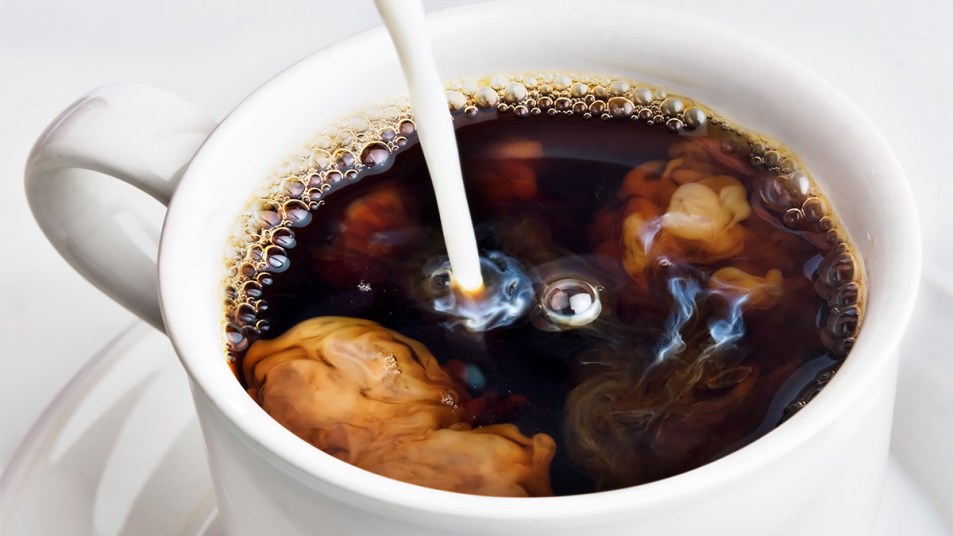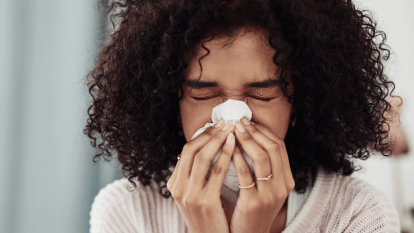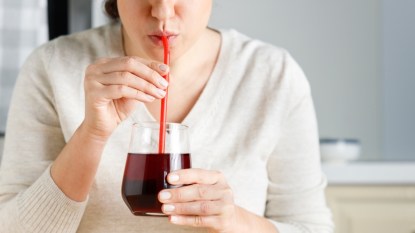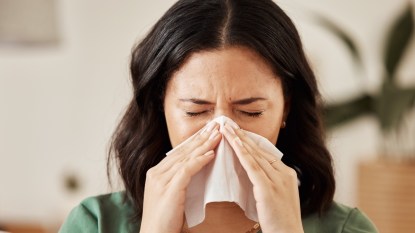How to Know If Curdled Milk Is Bad — And the Genius Trick That Keeps Coffee Curdle-Free
Nutrition pro reveals why seemingly "good" milk curdles when added to coffee — and how to outsmart it!

Nothing spoils a cup of coffee or bowl of cereal faster than curdled milk — those chunks and lumps that pop up are so unappetizing. But beyond the ick factor, is curdled milk bad for you? And what happens if you accidentally take a sip? Read on for a dietitian’s top advice, plus get her genius trick for keeping your coffee curdle-free.
Why milk curdles
“Curdling in milk is a result of a reaction between the proteins and acidic content,” explains registered nutritionist and dietitian Jillian Kubala, MS, RD. “When milk becomes too acidic — like when it spoils or when it’s introduced to an acidic environment like coffee — the pH drops and becomes less neutral. This change in pH causes the casein proteins in the milk to bind together, creating curdles or clumps.”
The 2 main types of milk curdling
Not all curdling is bad — in fact, milk is purposely curdled as part of the yogurt and cheese making process. Plus, it gives cottage cheese its signature curds. There are a variety of ways to make milk curdle such as adding heat or acid or simply letting the milk age long enough. (Click through to find out how intentional curdling can help you make your own buttermilk or yogurt at home.)
As for unintentional curdling, well, that looks more like those infamous lumps and clumps that come from the milk carton in your fridge that’s been sitting there too long. This is due to natural changes in the milk’s pH during its storage life once the lactose (or “milk sugar”) turns into lactic acid. That shift in acidity leads to the formation of curdles.
What happens if you drink milk that’s spoiled?
Kubala warns that “if the milk has curdled due to spoilage, it’s best avoided as harmful bacteria might have proliferated.” These can include salmonella, which can cause a nasty bout of food poisoning with symptoms like nausea, diarrhea and fever.
It’s worth noting that the sell-by date on the carton doesn’t indicate when the milk will go bad but rather how long stores should have it on display. Because of this, you’re better off using your natural senses to determine if a container of milk has spoiled. First, do a sniff test since one of the biggest signs of spoiled milk is a sour, pungent odor. Next, check the appearance of the milk while it’s still inside the actual carton — you might be able to spot curdles. And of course, if you do a taste test and the flavor is tart, it’s definitely time to toss it. (Click through to learn more on why you shouldn’t trust the sell-by date on a milk carton.)
Why does milk curdle in coffee?
Ever notice that milk may seem fine in the carton but then curdles as soon as you add it to coffee? It might not actually be spoiled! The age-old notion that hot and cold liquids don’t mix well applies to milk and coffee. Quickly splashing fridge-cold milk into a hot cup of coffee can cause curdling due to the sudden temperature change.
Another factor: Coffee is naturally acidic, and while milk is closer to being “neutral” on the pH scale, it becomes more acidic the longer it’s stored. So mixing older dairy and coffee dramatically ups the acid level, speeding up the curdling process. (Click through for more on coffee add-ins that can help you lose weight like protein powder, sugar-free syrups and MCT oil.)
Although this type of curdling isn’t necessarily bad for your health, it’s also not ideal since the milk chunks can make your cup of joe taste tangy. Luckily, you avoid this by using fresh milk when possible and even changing the order that you mix the coffee and milk together. “Try adding the milk to the cup first, then slowly pour the coffee,” Kubala suggests. You might even want to heat that milk up in the microwave for a few seconds — this will help avoid curdling and deliver a hotter cup of Joe.
Ultimately, curdled milk isn’t always a bad thing — but just double-check that it hasn’t spoiled. And as the saying goes: When in doubt, throw it out!
Keep reading for more on when it is or isn’t safe to consume other pantry staples:
What Happens If You Accidentally Eat Mold?
Is It Safe To Drink Tea With a Film on Top?
If You’re Throwing Out Sprouted Onions You Need to Read This
This content is not a substitute for professional medical advice or diagnosis. Always consult your physician before pursuing any treatment plan.













